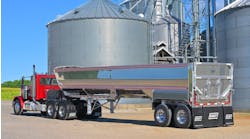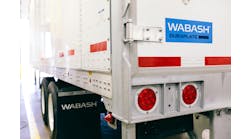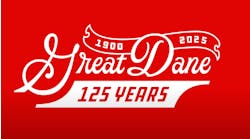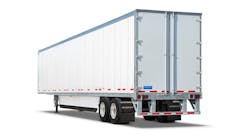Almost every truck trailer manufacturer exhibiting at the Mid-America Trucking Show in Louisville, Kentucky, featured new and innovative ways to take more weight out of the construction.
This trend has been true for years, but the competition to achieve lightest tare weight without sacrificing strength was even more evident at this, the 37th annual Mid-America Trucking Show, held March 27 to 29 at the Kentucky Exposition Center.
This was the largest show in the history of North American trucking shows, covering over a million square feet of indoor exhibit space in greatly enlarged halls with better lighting than ever, plus 250,000 sq ft of outdoor exhibit space. Some 1,150 companies exhibited their truck-related products and services.
Pictured here and on following pages are some of the newest trailer innovations on display.
Trailmobile sidewalls combine steel, aluminum plates
Trailmobile's UltraLight Plate sidewall is a “hybrid composite” that achieves significant weight reductions. The quarter-inch-thick composite panel has a .016-inch prepainted white galvanized steel interior skin, but the exterior skin is .035-inch prepainted aluminum. This lighter “hybrid” composite is combined with a very deep 21.5" bottom rail that also serves as a 16" high interior scuff plate of half-inch-thick aluminum. The trailer has an inside width at the scuff of 101". Trailer width panel-to-panel is 101□".
The hybrid steel-aluminum composite panels are joined by 16-gauge 80,000-psi steel posts on 48" centers. These anti-snag posts are punched with A slots for material handling and have a depth of 9/32". The 53-ft van trailer volume is listed as 4,066 cubic feet.
To get the 1,906 lb advertised weight reduction, Trailmobile also switched from steel to aluminum roof bows on 24" centers, mounted an aluminum front wall, installed a Havco 13/16" composite floor instead of hardwood flooring, and mounted the trailer on single aluminum wheels with super-single tires and aluminum hubs, among other weight-saving measures. Weight of the 53-ft trailer is posted at 11,980 lb.
Vanguard National Trailer Corp's pultruded composite floor saves 700 lb
A pultruded composite floor is just one of the innovations that Vanguard National Trailer Corp introduced at the Mid-America Trucking Show. The first of these FRP composite floors was installed in the show trailer as four floor “planks” full length of the trailer and 1½" thick. The floor is rated for 18,000-lb fork truck loads. This $300 option “could take up to 700 lb of weight off a 53-ft trailer without negatively impacting trailer integrity, according to Mark Roush, Vanguard director of engineering.
A second innovation is adhesively joining the composite plate sidewall panels. Instead of riveting an exterior steel post and an interior steel post to the composite plates on 48" centers, the new adhesive joining method uses an H-shaped extrusion that provides a slot on each side for insertion of the two composite plate panels to be joined. A two-part acrylic adhesive developing 2,200 psi holds the plates in the slots. The central portion of the extruded post also has grooves that hold a steel insert that is punched to make it a logistics post.
A third innovation is putting the maintenance manual and service information on a microchip in the electrical nose box where it can be accessed via a USB port. A second port is provided so that the trailer owner can add all service information as it is performed.
A mock-up of a trailer roof in the booth demonstrated how Vanguard has streamlined its roofing station in its Monon, Indiana, trailer plant. Instead of drilling and riveting the roof sheet to the upper rail, Monon uses self-piercing rivets that make their own holes as the automatic driving machine moves unassisted along the upper rail. This greatly reduces the number of workers required at the roofing station.
Vanguard also announced that it has expanded its product line to include pup trailers and converter dollies. The company now has 200 service locations, and in 2008 is adding a parts distribution center in Portland, Oregon.
Utility Trailer adds ‘Composite Core’
Utility Trailer has pursued a thinwall post-and-sheet design as a better way to achieve strength, high cube, and light weight. Now Utility is adding a “composite” element to its design.
Essentially the company is adding reefer foam technology to a dry freight van to allow the interior lining to work with the outside trailer skin in supporting the load, explains Jeff Bennett, vice-president for engineering at Utility Trailer.
The 4000D-X thinwall sheet-and-post van was introduced in 2004 and now accounts for 75% of all dry-freight vans produced by Utility. It differs from previous sheet-and-post designs in that the interior lining is a sheet of .019" thick high-strength, galvanized and prepainted steel, formed to be snag-free and riveted to the inside of the sidewall posts. This provides the potential for logistics posts to be spaced on 16" or 24" centers, and also allows damaged lining to be removed as individual panels.
A major advantage is that the thinwall design offers the same 101" interior width as most composite plate vans. And now Utility is injecting polyurethane foam into the space between the inner lining and exterior skin, making it closer to a composite plate trailer. In fact, Utility calls this a “composite sidewall” rather than a “composite plate sidewall.”
With the interior steel lining and exterior aluminum skin working together, it is possible to reduce the thickness of the exterior skin. Utility is continuing with the standard .050 aluminum sheet in the sidewalls for the highest stressed areas — over the rear tandem, upper coupler, and landing gear. Lower stressed areas in the middle of the trailer can now be reduced to .040" aluminum, thus reducing weight and cost. Weight of the 53-ft, 102" wide 4000D-X on aluminum dual wheels exhibited in Louisville was listed at 12,380 lb.
Collapsible TrailerTail extension improves fuel efficiency 5%
Utility Trailer and ATDynamics Inc jointly launched the new aerodynamic TrailerTail at the Mid-America show. The collapsible TrailerTail extension is attached to the rear of a Utility Trailer 4000D-X dry freight van that is an EPA certified Smartway trailer.
ATDynamics is an affiliate of the Environmental Protection Agency's Smartway Transport Partnership, a voluntary program designed to accelerate the trucking industry's efforts to conserve fuel and reduce emissions. Utility Trailer was the first trailer manufacturer to offer a qualifying model, the 4000D-X, to be certified by the EPA as a Smartway trailer, according to Craig Bennett, senior VP sales and marketing at Utility. To qualify for Smartway certification, a trailer must achieve 6.5% or greater total fuel savings through such measures as low rolling-resistance tires, side skirts, a front gap-reducing device, or rear drag-reducing device.
The TrailerTail is constructed of lightweight panels that are attached by patented hinges to the rear of a van trailer. When deployed, they extend the length of the trailer by four feet, but collapse to only two inches
Third-party SAE J1321 testing conducted by Robert Transportation at Energotest 2007 in Montreal, Canada, showed that the TrailerTail can reduce fuel consumption by 5.1% at 62 mph. At 68 mph, the device yields potential efficiency gains greater than 6%.
Wabash National shows new concepts
The smallest and lightest weight van trailer exhibited at the Mid-America Trucking Show was a pint-size miniature constructed solely to demonstrate new concepts being considered for future production trailers at Wabash National Trailer Corp. Customers were shown a number of new concepts and asked their opinions. Among them were these:
- A DuraPlate roof, using the same quarter-inch thick composite plate as the sidewall material, but arching the plate to shed water. This would eliminate all roof bows, because the curved DuraPlate would hold its shape. It would be riveted to the upper rail around the perimeter, but individual panels would be adhesively joined. This would add about one inch to interior trailer height.
- Portholes in the sidewall would admit daylight instead of using translucent roof sheets.
- Adhesively joined DuraPlate sidewall panels would eliminate side posts and rivets and give the trailer a cleaner look for better display of large decals.
- Logistics tracks would not be in posts on 48" centers but spaced at any distance at the option of the buyer. These punched tracks would be bonded to the sidewall and be only as tall as necessary for cargo control.
- New door lock rods would have stronger thrust bearings top and bottom to eliminate racking at rear doors.
- New patented door operating handles mounted below the door would lock into the rear threshold plate, then swing around to serve as door holdbacks by locking into the lower side rail. Doors then would be held tighter against the sidewall to reduce sideswipe damage.
- Thin, flat side marker lamp would have a circuit board and diodes cast in the lens material to provide lowest profile against damage. Only one small hole would be required to be drilled in the trailer side rail for the wiring connector.
- Rear stop-turn lamps also would have diodes and circuit boards cast in the lens material and thin enough to be flange-mounted inside the light box to prevent theft.
MAC debuts aluminum telescoping trailer
The MAC Xtender is a new 48- to 80-ft telescoping frame trailer making its debut at the Mid-America Trucking Show in Louisville.
MAC president Michael A Conney says this is the first time a telescoping platform trailer has been done in all-aluminum. His company in Alliance, Ohio, specializes in aluminum dump bodies and trailers, aluminum platforms, and aluminum transfer trailers.
The prototype Xtender has been operating for over a year in Michigan. The owner operates a fleet of all-aluminum platforms and wanted a telescoping trailer that also could be used in regular flatbed service rather than standing idle between long loads. The new model is rated at 70,000 lb for self-supporting loads such as long beams, or 60,000 lb concentrated in four feet. Tare weight is 13,400 lb, compared to an estimated 17,000 lb for a steel telescoping trailer.
The main trailer frame is a rectangular box section 26" deep. The extension frame is an 18" deep I-beam fabricated from two T-section extrusions. A patented locking mechanism has stops at 48, 53, 60, 66, 71½, 76, and 80 feet. When Teflon slides proved inadequate to slip the telescoping section, a retractable roller system applied with air bags was added.
Clement dump trailer goes aluminum
Clement Industries in Minden, Louisiana, is noted for its steel line of dump trailers, rock haulers, demolition trailers, and bottom dumps. But the company went all-aluminum on its newest end dump introduced at Mid-America in Louisville.
While it appears to be a standard exterior post design, it is definitely designed for the 21st century. That's because the all-welded body is designed for automatic welding. Production will start in June when the new plant for aluminum trailers is completed.
Trail King dry bulker less bulky
The new Advantage 1033 pneumatic dry bulk hauler from Trail King Industries has been redesigned for lighter weight — as light as 8,340 pounds, down from 8,800 lb formerly.
Among the principal weight reduction areas were the steel struts and end frames, which were changed to aluminum. Going to a heavier gauge aluminum (.210") in the tank shell meant that internal bracing could be eliminated. A lighter version of the Hendrickson Intraax suspension (the AANT 23K) delivers more weight savings. The 1033-cubic-foot capacity dry bulk trailer is manufactured in Trail King's Brookville PA plant.
Fontaine adds Revolution platform combo
Last year's Revolution platform introduced by Fontaine Trailer Company was back at this year's Mid-America Trucking Show, this time as a combo platform with a steel frame. It still has the all-aluminum deck where all the extrusions run across the trailer, acting as both crossmembers and deck. That smooths out the underside for lowest air drag, and the topside has load-securement channels to eliminate the need for nailing strips. The unitized construction is made possible by friction-stir welding technology. The 48-ft, 102" wide combo platform has a distributed load capacity of 80,000 lb. It weighs 9,000 lb, which is about 1,200 lb less than most steel-aluminum combo platforms. It is also about 1,200 lb heavier than the all-aluminum Revolution.
Sliding-axle trailer loads at 6-degree angle
The X-L Super Slider from X-L Specialized Trailers uses a gear track rather than hydraulic cylinders to pull the axles forward. This allows the axles to move farther forward when not limited by the length of the hydraulic cylinder, resulting in a 6 degree loading angle for the 37-ft main deck. The 48-ft trailer has a distributed load capacity of 70,000 lb, or 50,000 lb concentrated in 10 feet.
Platform trailer staircase for aging drivers
A platform trailer customer complained that his drivers are getting older and can no longer climb onto a flatbed easily. East Manufacturing built the stairs into the rear of the trailer, complete with a fold-down deck capable of handling fork truck loads. The customer bought 25 more. Another customer saw them and ordered 50. Now it is a regular option at East Manufacturing in Randolph, Ohio.
40-year-old East trailer still working
To help celebrate its 40th anniversary this year, East Manufacturing in Randolph, Ohio, went looking for the original East aluminum trailer that started it all 40 years ago. They found it, although not with its original owner. It was still working and still in good repair. It was washed and cleaned, fitted with a new tailgate, and it was ready for the exhibit floor at the Mid-America Trucking Show in Louisville KY.
The original trailer buyer, Tom Shields, used that first East aluminum dump trailer for 10 years hauling coal in Harrisville, Ohio, before moving on to a newer model. He attended the show in Louisville to give testimony to the durability of the product and give the company a plaque in appreciation. He is still hauling coal, now with a 2001 East all-aluminum dump trailer.








